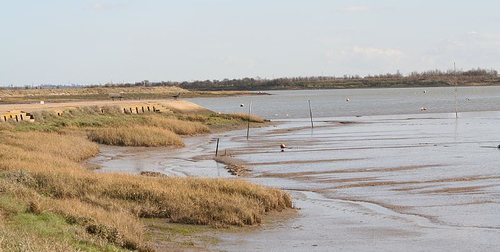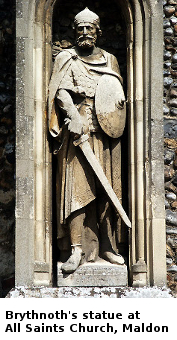
The Battle of Maldon sometimes called Byrhtnoth’s Death
|
The Battle of Maldon is a fragment of 325 lines of a heroic Saxon poem from a lost manuscript. The battle between Vikings and Saxons took place near Maldon, Essex in 991 and the poem was composed around 995, but nothing is known about its author. Its hero is pronounced ‘Brithnoth’. The death of Byrhtnoth, an ealdorman of Essex, was recorded in three versions of the Anglo-Saxon Chronicle. The Peterborough manuscript records:   Her wæs Gypeswic gehergod, 7 æfter þæm swyðe raþe wæs Byrihtnoð ealdorman ofslagan æt Meldune. 7 on þam geare man gerædde þæt man geald ærest gafol Deniscum mannum for þam myclan brogan þe hi worhton be þam særiman, þæt wæs ærest .x. þusend punda. Þæne ræd gerædde ærest Syric arcebisceop. The leader referred to as Anlaf is Olaf Tryggvason (968-1000 AD), the future king of Norway. The abbey calendars of Ramsey and Winchester record Byrhtnoth’s death on 11 August 991, but Ely, which he had endowed, firmly records the previous day. The poem is one of the most famous writings in Old English which have survived.
It was probably written at the end of the tenth century since the spelling of
Byrhtnoth’s name underwent a permanent change to Brythnoth quite early
in the 11th century and the poem uses the original form. In addition the historical
existence of some of the participants named in the poem has been supported by evidence
elsewhere and the poet's acquaintance with them suggests an early date for the composition.
The many stylised speeches are clearly fictional and the author makes the action point
the moral of the tale.
His tomb inscription says: "Brithnoth, Duke of Northumberland, killed in battle by the Danes 991 AD" The Story as told in: It was in the year 991 that the Northman Anlaf sailed with ninety-three ships to the coast of England, and after harrying Stone, Sandwich and Ipswich, came to Maeldune (now Maldon) on the banks of the river Panta or Blackwater. The stream divides here into two branches, and, leaving their ships at anchor in one of them, the Danes drew up their forces on the intervening piece of land. The poem, the beginning and end of which are lost, opens with the directions of Byrhtnoth to his men, and tells how, after marshalling his troops, he exhorted them to stand firm, taking his place among the band of his immediate followers. At that moment there appeared on the other side of the stream the viking herald, who said that he was sent by the seamen to announce that, if Byrhtnoth would buy off the assault with tribute, they would make peace with him and return to their own land. But Byrhtnoth scornfully rejected the offer, saying that he would give tribute, indeed, but it should be the tribute of the sharp spear and the ancient sword, and their only booty would be battle. With this message he bade his men advance to the edge of the stream; but, owing to the inflowing flood after the ebb, neither army could reach the other, and they waited in battle array till the tide’s going out. Then Byrhtnoth, overweeningly daring, trusting too much in his own strength, allowed the enemy to cross by the bridge (probably one of stepping-stones which would be covered at high tide), and the fight became fierce. “The time had come for the fated men to fall; then was a tumult raised, the raven, eager for carrion, hovered in the air, and on earth was a great cry.” On every side fell the heroes; a kinsman of Byrhtnoth was wounded, and, at last, the brave earl himself was slain by a poisoned spear. With his last words he exhorted his men to resistance, and died commending his soul to God. True to the noble traditions of the heroic age, Ælfnoth and Wulfmær shared his faith and fell, hewn down by the heathen beside their lord. Then cowards began to flee and seek safety in the woods, forgetting the brave words they had spoken when feasting in the mead-hall. But Ælfwine, the son of Ælfric, shouted to those fleeing, reminding them of their vows, and declaring that none among his race should twit him with flight, now that his prince lay fallen in battle, he who was both his kinsman and his lord. His brave words were taken up by Offa and Dunnere; and the warriors advanced to a fresh attack. The appearance amongst the defending ranks of Æschere, son of Ecglaf, a Northumbrian hostage is of great interest, as it seems, for a moment, to give us a vivid glance of the political troubles of the land. The poem ends by telling how Godric exhorted his comrades and fought fiercely against the heathen till he too fell. |